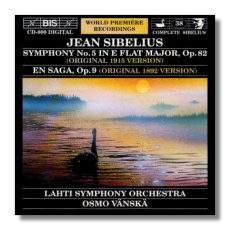
The Internet's Premier Classical Music Source
Related Links
- Sibelius Reviews
- Latest Reviews
- More Reviews
-
By Composer
-
Collections
DVD & Blu-ray
Books
Concert Reviews
Articles/Interviews
Software
Audio
Search Amazon
Recommended Links
Site News
 CD Review
CD Review
Jean Sibelius

Original Versions
- Symphony #5 in E Flat, Op. 82 (1915 version)
- En Saga (1892 version)
Lahti Symphony Orchestra/Osmo Vänskä
BIS CD-800 DDD 58:05
Composer, beware! When you complete a work, destroy all your drafts, and if you revise it, burn the previous version… unless you like musicologists, musicians, and record companies picking through your trash and and putting it up for the public's inspection.
Well OK, these "original versions" certainly are very interesting windows into Sibelius's thought processes. Musically, they're of more than passing interest as well. The four-movement version of the Fifth Symphony recorded here was first heard in 1915. Despite critical approval, Sibelius was not satisfied with it and wanted to give it "another - more human - form," and so there were revisions completed in 1916 and 1919. The three-movement revision of 1919 is the one that was published and is performed and recorded today.
Was Sibelius right to rethink the original version? I think he was. Even though he made some interesting, even daring, choices the first time around, the final version is tighter and more convincingly argued. The composer's conflation of the two opening movements (1915) into one (1919) improves the symphony's flow, and the revised orchestration is more characterful. Note that the original version ends with a much diluted statement of the strong, hammer-like chords that end the symphony as it now stands. On the other hand, the more leisurely unfolding of the first movement's material creates some lovely moments, and the expanded version of the Finale (some 200 bars longer here) is notable for its grandeur and its shocking harmonies. (At one point, a Finnish fly must have been squashed on Sibelius's music paper.) If you love this symphony as much as I do, then you can't help being thrilled when the original version gives you more of it to love.
Similar comments can be made for En Saga. Here, BIS allows us to hear Sibelius's original thoughts from 1892; it is the final 1902 version that we are familiar with. Again, the original version is almost 150 bars longer. Brasher, more primitive, and more mercurial than the monolithic final version, it contains thematic material that Sibelius later removed as he tightened the work's structure.
Vänskä and the excellent Lahti SO are accustomed to presenting alternate versions of Sibelius's music: this Finnish team won a Gramophone Award for their recording of the original version of the Violin Concerto. This CD is just as illuminating and well performed, and the engineering is outstanding. Obviously, these performances shouldn't exclude recordings of the final versions of these works (Jukka-Pekka Saraste's recordings are a good modern choice), but all good Sibelians will want to hear them and will not be disappointed.
Copyright © 1998, Raymond Tuttle


















